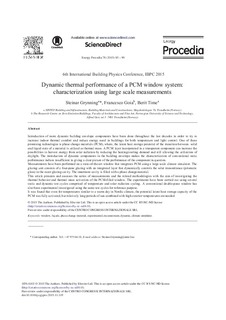| dc.contributor.author | Grynning, Steinar | |
| dc.contributor.author | Goia, Francesco | |
| dc.contributor.author | Time, Berit | |
| dc.date.accessioned | 2016-01-08T11:45:49Z | |
| dc.date.accessioned | 2016-03-04T15:39:46Z | |
| dc.date.available | 2016-01-08T11:45:49Z | |
| dc.date.available | 2016-03-04T15:39:46Z | |
| dc.date.issued | 2015 | |
| dc.identifier.citation | Energy Procedia 2015, 78:85-90 | nb_NO |
| dc.identifier.issn | 1876-6102 | |
| dc.identifier.uri | http://hdl.handle.net/11250/2381574 | |
| dc.description.abstract | Introdution of more dynamic building envelope components have been done throughout the last decades in order to try to increase indoor thermal comfort and reduce energy need in buildings for both temperature and light control. One of these promising technologies is phase change materials (PCM), where, the latent heat storage potential of the transition between solid and liquid state of a material is utilized as thermal mass. A PCM layer incorporated in a transparent component can increase the possibilities to harvest energy from solar radiation by reducing the heating/cooling demand and still allowing the utilization of daylight. The introduction of dynamic components in the building envelope makes the characterization of conventional static performance indices insufficient in giving a clear picture of the performance of the component in question.
Measurements have been performed on a state-of-the-art window that integrates PCM using a large scale climate simulator. The glazing unit consists of a four-pane glazing with an integrated layer that dynamically controls the solar transmittance (prismatic glass) in the outer glazing cavity. The innermost cavity is filled with a phase change material.
This article presents and assesses the series of measurements and the related methodologies with the aim of investigating the thermal behavior and thermal mass activation of the PCM-filled window. The experiments have been carried out using several static and dynamic test cycles comprised of temperature and solar radiation cycling. A conventional double-pane window has also been experimental investigated using the same test cycles for reference purpose.
It was found that even for temperatures similar to a warm day in Nordic climate, the potential latent heat storage capacity of the PCM was fully activated, but relatively long periods of sun combined with high exterior temperatures are needed.
Keywords: window;
façade;
phase change material;
experimental;
measurement;
dynamic;
climate simulator | nb_NO |
| dc.language.iso | eng | nb_NO |
| dc.publisher | Elsevier | nb_NO |
| dc.title | Dynamic thermal performance of a PCM window system:characterization using large scale measurements | nb_NO |
| dc.type | Peer reviewed | nb_NO |
| dc.type | Journal article | en_GB |
| dc.date.updated | 2016-01-08T11:45:49Z | |
| dc.source.volume | 78 | nb_NO |
| dc.source.journal | Energy Procedia | nb_NO |
| dc.identifier.doi | 10.1016/j.egypro.2015.11.119 | |
| dc.identifier.cristin | 1308605 | |
| dc.description.localcode | © 2015 The Authors. Published by Elsevier Ltd. This is an open access article under the CC BY-NC-ND license. | nb_NO |
